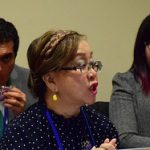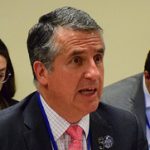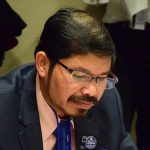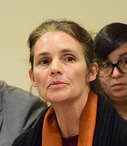
Search
Posts del March, 2019
Oxford University launches social enterprise to help business fight poverty
sOPHIa’s goal is to provide businesses with tools to measure and respond to poverty amongst their employees and their families, contractors, and in their supply chain. In addition, sOPHIa plans to offer companies the ability to be audited to verify that they have met standards in implementing the bMPI and programs to impact the poverty of employees. Companies meeting the standards will receive a seal to demonstrate their commitment to ending poverty.
Since 2014, OPHI had partnered with Horizonte Positivo to help the Costa Rican Government develop its National MPI, with the bMPI following in 2017 with a launch in Costa Rica. The bMPI initiative began when the Chairman of BAC Credomatic Bank, Costa Rica, Ernesto Castegnaro, asked at a meeting of the Horizonte Positivo Board, if there might be any multidimensional poverty in his bank and an initial survey revealed more employee household poverty than expected. The same result was received in two other pilot companies, Purdy Motors, Costa Rica’s Toyota dealer and the public relations agency CCK Central America. Horizonte Positivo then tested and applied the bMPI in the private sector. Horizonte Positivo now provides assistance to 39 companies involved across business sectors of Costa Rica.
sOPHIa is currently being funded from individuals in the UK and USA and in Costa Rica to date the bMPI is funded by fees from companies. The Costa Rica program expects to work with 100 companies in 2019.
Federico Odio, Country Manager BAC Credomatic Costa Rica, said:
“We are particularly proud of our initiatives to eradicate poverty within our staff and reduce it significantly in our country. BAC Credomatic was the first bank in the world to apply Oxford’s Multidimensional Poverty Index with its staff, identifying that 12 percent of them were living under poverty conditions. BAC Possibilities is a program designed by the bank to eradicate poverty within its staff. It consists of subsidised loans—supported by donations from its own managers; psychological support; financial coaching, and a care network for elderly, disabled or very young family members. The bank hopes that this program will be exported to its corporate clients so that they, in turn, can eradicate poverty within their staffs and have significant impacts on the financial wellbeing of the country’s population.”
Jamie Coats, President of sOPHIa Oxford, said:
“Corporate leaders pursuing purpose and profits want objective measures to be able to manage against and be efficient as they respond to poverty within their companies. The Oxford University developed Business Multidimensional Poverty Index is a new tool for company information systems to help align corporate values and operations. In Costa Rica we have seen it be both effective and inspiring for employees and managers.”
The creation of the sOPHIa Oxford and its licence from Oxford were supported by the Oxford Department of International Development and the University’s innovation arm, Oxford University Innovation (OUI). OUI launched the social enterprise option in September 2018 to offer Oxford’s academics the opportunity to create companies which put people before profit. Since the launch of the programme, OUI has rapidly built up a pipeline of 30 social enterprises which it intends to launch over the coming months and years.
Dr Mark Mann, Innovation Lead for Humanities and Social Sciences, Oxford University Innovation, said:
“This is the University’s first social enterprise spinout, the first of a rapidly growing pipeline which comes from all academic divisions of the University. If you look at the breadth and depth of the research the University publishes, there are many potential solutions to the world’s problems that can be rolled out. Social Enterprise can be a great vehicle for delivering impact to people in need and I am particularly excited about the potential of sOPHIa to bring people out of poverty across Latin America and beyond.”
Basil Postan, a UK-based donor to sOPHIa, added:
“Over the ten years that I have been an external supporter of OPHI I have seen their pioneering work on the multi-dimensional measurement of poverty, led by Sabina Alkire, become increasingly recognised as a standard for multi-national and national policy makers. Coming from the world of finance and investment I have always thought that OPHI’s methodologies could also be naturally extended as powerful management tools for good governance in the private sector: to allow companies to identify dimensions of poverty and deprivation among their employees and their families; and to promote corrective policies and actions.
The creation of sOPHIa Oxford, as a social enterprise start-up venture, plans to do just this – licensing OPHI’s proprietary know-how to corporate clients, and establishing it as an internationally recognised benchmark for good corporate practice. I am thrilled, and honoured, to have been asked to be one of the initial funders of sOPHIa Oxford and would encourage others to join me in supporting this remarkable and very timely venture, to carry the innovative work being done at Oxford University into the global social marketplace.”
Javier Quirós, President Grupo Purdy Motor, Toyota Dealer Costa Rica, said:
“Purdy Motor Group has maintained itself over time as a great leader because, from the beginning, our organisation detected that the most important asset is the human talent of the Purdy People. Through the implementation of Business Multidimensional Poverty Index we have managed to know the family situations of our employees and thus be able to develop different projects dedicated to improving their quality of life from an integral perspective. The responsible entrepreneur is anyone who understands the impact that their operation has on the community, on the environment and mainly on their people. That is why I want to invite the representatives of the private sector to use the Business Multidimensional Poverty Index as a tool that will allow them to focus on what will really provide a long-term benefit for your employees and their families.”
Jose Aguilar Berrocal, Executive Director, Asociación Horizonte Positivo, said:
“The instrumental power of the bMPI model, consists in its ability to trigger action with generosity, empathy, and a strategic approach, based on rigorous data and measurable indicators that will not just guide the program design and resource allocation, but also enhance the corporate leaders with the possibility to continuously improve their programs through a precise monitoring of each project’s impact in each of their workers situation
It’s the best of both worlds, (1) The Brain: rigorous data driven work, clear methodologies, measurable programs and impact: (2) The Heart: empathy towards those who work in your corporation, helping you create value and true wealth. Employees, very often, silently endure hardships, that now can be known, and properly addressed.”
sOPHIa Oxford is receiving probono legal support from the Boston based law firm Goulston & Storrs. Partner Karin Rivard said:
“Goulston & Storrs fully supports sOPHIa Oxford’s mission. We believe that implementing the multi-dimensional index licensed by sOPHIa Oxford from Oxford University is an important mechanism to enable businesses and other stakeholders to more effectively respond to the root causes of poverty.”
UN Statistical Commission 50th Session – MPPN Side Event 2019
On 5th March 2019, the Multidimensional Poverty Peer Network (MPPN) hosted a side event at the 50th United Nations Statistical Commission titled “Multidimensional Poverty: Measurement for Action.” More than 70 statisticians and other stakeholders gathered in New York to discuss progress and issues with developing and implementing multidimensional poverty measures to reduce poverty and encourage policies that leave no one behind in the pursuit of the Sustainable Development Goals (SDG’s).
The side event was collegially chaired by Risenga Maluleke, the Statistician-General of Statistics South Africa. Speakers included representatives from OPHI and Directors of Statistics from Angola, Chad, Colombia, Kenya, Libya, Malaysia, Mexico, Mongolia, Nepal, Nigeria, Palestine, Philippines, Senegal, Sudan and Uganda.
Highlights include the following:
 Risenga Maluleke, Statistician-General of Statistics South Africa.
Risenga Maluleke, Statistician-General of Statistics South Africa.
“The next hour will be a real feast of interest. You will hear a cascade of presentations from 14 National Statisticians on multidimensional poverty metrics and how these are used in action to complement monetary poverty measures and fight poverty in all its dimensions.”
 Lisa Grace Bersales, National Statistician, Philippines
Lisa Grace Bersales, National Statistician, Philippines
“When we reported the MPI to our Philippines Statistics Authority Board, we told the different ministries that we will tell you where most Filipino families are most deprived. And when our Ministry of Budget heard this, they said: ‘Oh, we want to know that.’ Because when we approve proposals of budgets of certain sectors—health, education, labor—we want to know if indeed these are where the budget should be… So it’s not just about policy, but it’s also about where government financing will prioritize. This is really what we wanted the MPI to be focused on.”
See press release from the Philippines here
 Yemi Kale, Statistician General, National Bureau of Statistics, Nigeria
Yemi Kale, Statistician General, National Bureau of Statistics, Nigeria
“As far as policymakers are concerned, you see them asking for disaggregation of the MPI. It’s not just at the national level, but also at the state level. States want to know which deprivations are worse and you can see them actually designing policies to tackle certain areas.”
“This can also be used to locate where the poor are. So the National Social Safety Net was designed using the MPI numbers across different states to target those states and areas with the highest deprivations. And you can see that the policies were targeted towards those areas in designing the entire policy framework.”
 Julio Santaella, President, National Institute of Statistics and Geography (INEGI), Mexico
Julio Santaella, President, National Institute of Statistics and Geography (INEGI), Mexico
“In the definition of these variables [that go into the multidimensional poverty measure], of course, there is a huge and intense discussion between INEGI, the statistical office, and CONEVAL, the council, because we have to come up with implementation of these definitions. So it’s not only important to be conceptually rigorous, but it also has to be feasible to be applied on the ground.”
“Right now we are almost at 10 years of this measurement, and CONEVAL is going to redefine the methodology. The law has upgraded some of the rights—so, for instance, the level of education has gone beyond primary that is mandated by law to secondary level—so that is something that has to be included into this measure.”
 Juan Daniel Oviedo Arango, Director General, National Administrative Department of Statistics (DANE), Colombia
Juan Daniel Oviedo Arango, Director General, National Administrative Department of Statistics (DANE), Colombia
“The MPI is measurement for action because, at the first glance, we use the MPI as an accountability platform of how social policies are going to improve life quality conditions of our citizens.”
“The MPI not only was used as an accountability platform but also as a strategic policy designing instrument. So all the socio-economic policy of our government turned around the MPI.”
“The MPI is also a very good example in our country of good governance. An MPI needs rigor and independence in the measurement because it cannot be just a government-biased indicator, but it has to be really independent.”
 Nour Goukouni Nour, Director General, National Institute for Statistics, Economic and Demographic Studies (INSEED), Chad
Nour Goukouni Nour, Director General, National Institute for Statistics, Economic and Demographic Studies (INSEED), Chad
“For a better evaluation of the Sustainable Development Goals, and especially to have information to feed into the 2017-2021 Five-Year Plan, it is important to develop socioeconomic indicators that can capture, from many angles, the indicators of poverty in a multidimensional approach.”
“The results of the MPI will provide the Government with the necessary information to better guide public policies in measuring poverty and well-being, to geographically target vulnerable groups, to monitor and evaluate poverty reduction, and to monitor SDG indicators.”
 Mohd Uzir Mahidin, Chief Statistician, Department of Statistics, Malaysia
Mohd Uzir Mahidin, Chief Statistician, Department of Statistics, Malaysia
“In line with the introduction of the MPI in the 2010 Human Development Report, Malaysia has developed a national measurement of MPI that is appropriate to the socio-economic well-being and development framework of the nation. The use of the MPI will ensure that policy evaluation will shift beyond poverty to include vulnerability as well. The MPI will complement the BLI measure and monetary poverty from a multidimensional perspective.”
“The MPI we compute reflects both the incidence of multidimensional poverty deprivation, as well as the intensity.”
 Ariunzaya Ayush, Chairperson, National Statistics Office, Mongolia
Ariunzaya Ayush, Chairperson, National Statistics Office, Mongolia
“In 2017, Mongolia conducted a pilot survey and covered three counties. We tried to measure the MPI in four dimensions, having Education; Health; Housing conditions; and Standard of living. … We understood that we had to organise discussions on selected indicators between multi-stakeholders in the government to see which indicators we need. So we are working now with the World Bank on projects, taking deeper surveys on nomadic households and we also have an ADB project which is working on SDG indicators, and especially working on Multidimensional indicators.”
 Camilo Simão Ferreira de Ceita, Director General, National Institute of Statistics, Angola
Camilo Simão Ferreira de Ceita, Director General, National Institute of Statistics, Angola
“… what we need to do is come up with our own definitions for our own MPI, so we started the process with OPHI’s support through a national consultation to define the dimensions and the indicators. We think the dimensions will be Health; Education; and Standard of Living. We count on the support of Statistics South Africa, they have a lot of experience in this issue, and of course on OPHI to give us support and I think it will happen in May. I think this will be a revolution about poverty in Angola.”
Abdella Zidan Allag, Chairman, Bureau of Statistics and Census, Libya
“We took an opportunity because there was a survey done in 2016 and we used that data to measure the MPI for Libya. We concentrated on three dimensions – Work and Education as one dimension; Health; and Living Standards. The values from this index are reliable because when we go through them, they show the truth of poverty in Libya. This report has succeeded in providing indicators we can rely on because we didn’t have a measure before, so this is a great opportunity for us to have indicators to assess the first goal of the SGD’s.”
Palestine Central Bureau of Statistics
“In 2014, we started working on the MPI with the national committee in Palestine and with consultants from ESCWA. We also conducted the households consumption and expenditure survey in 2016/2017, and we also have the census 2017 – we are working on the MPI using the big survey and the census. The National Policy Agenda 2017-2022 highlights “Putting Citizens First”, and in response to that, we are working to have Multidimensional variable design besides the income line”.
 Babacar Ndir, Director General, National Agency of Statistics and Demography (ANSD), Senegal
Babacar Ndir, Director General, National Agency of Statistics and Demography (ANSD), Senegal
“In Senegal the MPI was developed by the Observatory of Quality and Living conditions. The Observatory is an association of government and statisticians – like Ministry of Economy, the ANSD, Ministry of Social Development, Social Economy and so and so. Also, the private sector and civil society. And this framework has been put place to better take into account the implications of the MPI in public policies. The process of developing the MPI has followed different steps suggested by the Alkire-Foster methodology. The steps are as follows – first was to analyse the existing situation. The second step was to set the units of identification, and the third is to choose MPI parameters. And this choice developed slowly, and 5 dimensions were selected – Education; Health; Reading Conditions; Employment; Governance and Institutions.”
Imelda Madgalene Atai, Acting Executive Director, Uganda Bureau of Statistics
“The analysis of the MPI is based on the 2016/17 Uganda National Household Survey (UNHS 2016/17), UDHS 2016, and the UNPS. The Alkire Foster (AF) methodology is adopted in the estimation of multidimensional poverty at national, rural/urban and sub-national levels (Alkire and Foster, 2011). The AF framework employs the dual-cut off approach (deprivation cut off and poverty cut off) to identify the poor. For the Uganda MPI, a household (and all its members) is considered poor if they fall short or is deprived in 40 percent of the weighted dimensions.
Dimensions and indicators for Poverty Include: Education, Health, Living Standards, Empowerment”
 Sabina Alkire, Director, Oxford Poverty & Human Development Initiative, University of Oxford
Sabina Alkire, Director, Oxford Poverty & Human Development Initiative, University of Oxford
“Some countries launched their National MPI’s in 2018 and are not here, like Nepal. And also, Child MPI’s like Panama. Also, in 2019, Sierra Leone, the President, released their National Development Report with their National MPI last week – so that’s the first of 2019 and there will be more countries launching official MPI’s in 2019.
The MPPN works mainly on national statistics, but also with many agencies – and national MPI’s are permanent official statistics like a monetary measures – which both reflect poor peoples’ experiences and also reflect the policy priority, including the SDG agenda at the national level. So we are very happy that to support this with UNDP we are releasing a new book shortly – it will be online – “How to build a National MPI” – It has both the statistical process and the policy process in the same book.
We are very grateful to each person here. And there are many here who haven’t spoken but whose expertise we really value and recognise. This is a network of people who are terribly committed, and I think by working together we can move this forward to the benefit of those we are working on behalf of.”
See power point presentation here
Pictures are available here.












Recent Comments